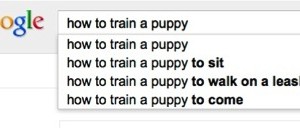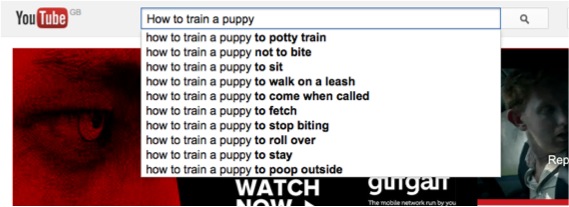Entries Tagged 'Content writer' ↓
August 5th, 2013 — Content marketing, Content writer
Is that the decision your company’s come to? 
Why do you think that?
Are you not getting the results you think you should be getting?
That’s probably because you’re not going about it the right way.
You see, content marketing is not about churning out loads of articles, sticking them on various websites in the vain hope of receiving a shed-load of valuable back links.
But don’t worry; you’re not the only one that feels like that because lots of companies are getting it wrong.
Why content marketing isn’t working
These are the main reasons why your content isn’t working.
1. Keywords
These little suckers count for 2 of the mistakes you may be making.
The first is that you’re focusing on high value keywords. If you’re trying to compete for a term such as ‘writing skills’, it’s unlikely your content will be found because it is highly competitive. It’s best to concentrate on something more specific, such as ‘website writing for the fashion industry’ or something along those lines. The more niche your term is, the less competition there is likely to be.
The second is that you’re using your keyword too often in your content. Do yourself a favour, stop counting the number you have in your text and just write naturally.
2. Going for quantity rather than quality
Many companies believe that more is, well more. Well, they’re wrong, because less is most definitely more.
Churning out loads of poor quality content will damage your business – fact.
But, investing in a smaller number of high quality articles will elevate your business to the heights you want to reach.
It’s far more important to produce high quality writing that adds value to your readers.
3. Over optimisation
For this one, less is definitely more.
Stuffing your keywords into your tags, descriptions and text will make the search engines groan and, in all probability, ignore your page.
Don’t try to play the system, because you will get found out and your rankings will suffer.
4. Be blinkered by rankings
Rankings used to be the be all and end all when it came to working out how successful your content strategy was.
Not any more.
Now, the search results you see depend on whether you’re logged into your Google account or not and your location. So, if you do a Google search on one of your keywords and see your content, there’s no guarantee they are the same set of results someone 100 miles away will be seeing.
It’s far more important to look at other metrics when gauging the success of your campaigns.
5. Social media fail
Using social media to boost your content marketing doesn’t equate to sending out a link and then forgetting about it. Instead you must use it in different ways, such as tweeting the link, running an opinion poll about it on Facebook, asking for feedback etc.
How to put your content marketing right
The main thing to remember is that you’re not writing to get links or rankings, you’re writing to benefit your readers.
Here are our top 8 tips to help you get on the right tracks:
- Content calendar – this will make sure you have a constant stream of quality content
- Add value – make sure everything you publish adds value to your readers
- Practical – offering practical advice and tips will help your readers and make them more likely to come back again (think about also adding videos and images)
- Optimise – not to excess, just make sure your title tags and meta descriptions are written to market your writing (i.e. write them to make the searcher want to visit your website)
- SEO – always check your SEO, for example for instances of duplicate content that will damage your rankings
- Images – not only is it important to use great images, it’s also essential you optimise their ALT tags
- Quality over quantity – rather than churning out loads of poor articles for links, publish a smaller number of high quality articles that will earn you genuine links
- Social – use social media A LOT
Try them out and see the positive effect these simple techniques will have in the success of your content marketing strategy.
Author: Sally Ormond, copywriter. Connect with her on Twitter and Google+
June 10th, 2013 — blogging, blogging for business, Content marketing, Content writer
One of the biggest barriers to content marketing faced by many businesses is ideas generation.
Many decide it’s not even worth considering because they don’t feel able to come up with the constant stream of information a content marketing strategy demands.
But it doesn’t have to be difficult to generate ideas; you just have to look at things a bit differently.
How do you go about coming up with content topics at the moment?
Do you just sit at your desk and stare into space hoping for a blinding flash of inspiration to strike?
That might happen now and then, but you can’t rely on that to generate the constant stream of ideas you need.
That’s where Google, Yahoo, YouTube, Quora, LinkedIn and your customers come in to their own.
Want to know more?
Google – the ideas machine
Google can help you in a couple of ways: through Google Suggest and its related searches results.
With Google Suggest, all you have to do is enter your keyword in the Google search box and then wait for Google Suggest to do its magic.
Below you can see that I entered ‘How to train a puppy’ as my keyword and then Google provided a list of alternative popular searches, providing me with a range of topics that I can write about.

As an added bonus, when you search for that keyword, at the bottom of the search engine results page Google then provides you with a further list of related search terms .

So, from one simple action I now have multiple ideas for content generation.
Yahoo! and Quora
I’ve put these two together as they work in fairly similar ways.
Yahoo! answers and Quora provide content marketers with a plethora of information. They are a great place to start your research. Browsing both sites, using your keywords, will throw up all sorts of ideas based on the questions being asked by users.
After all, if people are asking questions it means they are looking for answers, so they are the topics you want to be writing about.
YouTube
YouTube isn’t just a video viewing website, it’s also a great source for content ideas.
It works in a similar way to Google Suggest in so far as you enter your keyword into the search box and then YouTube will list other related searches.

As you can see I’ve used the same keyword as in the Google example, but here YouTube has come up with a different range of suggestions, so now, one keyword has generated several different content ideas.
LinkedIn groups
Are you a member of any LinkedIn groups? If so, you’ve probably seen the emails that are generated when someone poses a question. Again, these questions are a rich source for your content ideas. Use them to write informative articles that you can then post on LinkedIn, your blog and other article sites etc.
Customers
Last, but by no means least, are your customers.
What better source could there be? Talking to them directly, or monitoring their questions (via email and social media) will unearth a rich source of content ideas, giving them the information they want.
Generating ideas for your content marketing strategy is easy. All you have to do is decide on the subject area you want to cover and then do one or more of the above to generate a whole raft of ideas that you can write about.
Do you use any other methods to generate ideas? If so leave a comment below and share them with us, it would be really interesting to get your take on this subject.
Author:
Sally Ormond is MD and head copywriter at Briar Copywriting Ltd.
March 27th, 2013 — blog, blogging, blogging for business, Content marketing, Content writer
This is a guest post written by Jenn Greenleaf. The views expressed in this post are entirely the author’s own and may not reflect those of Freelance Copywriter’s Blog. If you are interested in submitting a guest post, please get in touch with your ideas
To some, building an audience is second nature. It seems like no matter what these business owners say or do online, they have a genuine following. How does this happen, you wonder? Before getting into that, let’s talk about why they are so
engaged with their audience. The main reason is business. There’s a secret I’m going to let you in on when it comes to building an audience – your business will grow proportionally in size. Here are some tips about how to build an audience.

Keep your blog updated frequently
(source:www.sxc.hu/photo/1165446)
Deliver Content Consistently
Avoid generalizations when writing on your website; instead write as though you were talking to them directly. Develop content that is specific to your niche, especially if you’re selling a specialized product or providing a particular service. Content can be in a variety of forms including blog posts, articles, newsletters, interviews with other experts in the field, product reviews. Visitors to your website want fresh material delivered regularly covering topics relating to their interests.
Offer Freebies
Everyone loves to get something for free, as long as it has perceived value. It’s a perfect way to gain a following for any blog or business. To maximize your benefit, make sure the recipient provides their email address so you can maintain contact. Provide mechanisms for your audience to share these freebies with their own audience on social media. It can be as simple as placing a request to share on the front cover of an e-book or employing a “pay with a tweet” deal, where the person only get the product if they tweet about it. Ebooks are an obvious candidate for free products, but there are many other possibilities including free Kindle books, White Papers, companion guides and webinars. Offer substantial value in the product and avoid using it as an opportunity to sell.

Your audience should never wonder if they are important enough to talk to
(source:www.sxc.hu/photo/948294)
Stay Engaged
Visitors are discouraged when a business owner spends little time posting quality content and rarely engages with readers. The lack of interaction makes the site feel barren and neglected. Provide an immediate and positive response for every blog comment, Facebook post, or tweet. This attention to detail builds respect and garners trust among your audience. As this trust continues to build so does your reputation and ultimately your business, because everyone like to do business with people they can trust.
The Bottom Line
Whether you use social media, search engine marketing or SEO to attract visitors, be as human as possible. Search engines don’t read your blog, people do. There is a fundamental shift occurring in the online world, away from writing for SEO to creating content for human beings. Building your audience is the best way to build a business and insulate yourself from any changes in the major search engines. Great content inspires people to share and gives your business yet more exposure.
Author: Jenn Greenleaf writes about a number of topics including gardening, parenting, and legal matters. You can find out more on reputation.com
March 13th, 2013 — blogging for business, Building a business, Content writer, Freelance advice, internet marketing, marketing, small business web marketing, social media, social media marketing
The following guest post was written by Luke Clum. The author’s views are entirely his own and may not reflect the views of FreelanceCopywritersBlog.com. If you are interested in producing a Guest Post for this blog, please get in touch with your ideas.
Content marketing is a fertile field for freelance writers these days; in fact, it’s one of the few areas in which opportunities for writers seem to be getting better, not exploding in a newspaper-fueled inferno. But good content writing jobs won’t fall in your lap just because you woke up one day and said, “I’ve got it! I’ll be a writer.” Getting these jobs requires building a portfolio, being highly adaptable, recognizing promising opportunities, and getting your work into the hands of the right people.
In many articles on the subject, you’ll often find the suggestion to join a content mill to build your portfolio, despite the pitiful rate of pay. This actually is a good first step if you’re really starting from scratch (you need to have something professional to show potential clients). But to really stand out from the masses of people calling themselves writers these days, you’ve got to consciously create content that really brands you as an industry and creative leader. Here are our top 4 tips for doing just that.
1. Become an Informational Resource
By now, you’ve probably been told a million times that you should start a blog to show prospective clients. Again, this is true, but keep in mind that since this is often a baseline (i.e. something that’s strange not to have but not particularly distinctive if you do) your blog or website has to stand out in some way. One of the best ways to do this is to pick a niche and brand yourself as an informational resource by producing a few great pieces of content.
As an example, take the cloud accounting service, Xero, which produced this cloud computing guide as a helpful resource for its current and potential customers. The guide not only addresses a very relevant and widespread question (“Just what is the cloud?”), but it also showcases the company as a fun, down to earth, and helpful brand. And, as an added benefit, stand-alone resources like this are far more likely to go viral than a single company website.
Much the same is the case for the insurance company Simply Business, which has branded itself as a business resource centre with things like this guide to social media success. While not all of the company’s potential customers will want to look through these resources, many will, meaning guides like these both widen the company’s audience and instantly establish their credibility.
While you won’t have the same resources as these companies, the point remains the same. Take the time to develop great informational content that can act as a standalone piece. If you have any interests or specialities as it is, create a resource that answers questions you know are common within that niche, or use the Google Keyword Tool to find what potential readers are searching for. With compelling, impressive resources like this, a potential client will learn a lot more about you than if you were to send them yet another top 10 list.
2. Volunteer…Strategically
Another way to find distinctive material for your content portfolio and to get your work out in front of movers and shakers is to volunteer at a place you really “get.” This could be at an organization that’s within the industry you’re looking to enter, or it could be a cause you’re really passionate about. Either way, sticking with your interests will put you in a position where you’ll be more likely to have those creative content ideas, and more convincing in you pitches to your volunteer clients. What’s more, if you’re writing for an organization’s website, you’ll likely gain a lot of exposure for your work while also adding to your portfolio. The better the job you do, the more likely the people you’re volunteering with will be to use you in their own businesses or refer you down the line.
3. Partner Up
Content writers don’t operate in a vacuum. Where once editors used to be a writer’s most crucial contact (and, don’t get me wrong, they’re still pretty high up there), now partnering with someone in a related industry, like graphic design or SEO, can be just as fruitful a venture. Having a freelance partner means doubling your networking ability. It can also make for a much more convincing sales pitch if you can bill yourselves as a one stop shop kind of place. What’s more, if you’re looking to create those specific resources previously mentioned but you don’t yet have a niche, partnering up can be just what you need, as you can then take your partner’s expertise and get it down in written form, establishing an expert’s reputation for you both.
4. Become a Microblogger on Social Media
Social media isn’t just about promoting your content (though that certainly is important). Twitter, Facebook and LinkedIn are all potential sites for microblogging. Through tweets and status updates, you can post helpful tips in your distinctive and creative voice. On Facebook and LinkedIn, you can write blog posts and join industry groups with discussion boards. These are all forms of content creation, and the more regularly and uniquely you embrace them, the more you’ll stand out.
Take-Away
When you’re a freelance content writer, your content is your marketing. Showing clients what you can do with the resources you create and the impact you can make on social media is showing them just what you can do for them, should they take you on board. Make it helpful, full of expertise, fun and interesting to read, and your content writing career will take off in no time.
Author Bio
Luke Clum is a graphic designer and writer from Seattle. Follow him on Twitter @lukeclum
February 20th, 2013 — article marketing, article writing, blog, blogging, blogging for business, Content marketing, Content writer
As an online marketer you understand the need for a constant stream of content.
Regardless of whether you’re a B2B or B2C business (i.e. whether you sell to other businesses or direct to consumers), to gain a strong foothold in the search results you must produce lots of high quality content.
The problem is, the time needed to produce that amount of content is rather hard to come by. We are all over worked and finding a few extra hours a week to write can be tough.
Of course, you can lighten the load by encouraging key staff members to produce content for you – many hands and all that – but there are also some other tricks you can use to help generate content and make the most of the stuff that’s already out there.
Recycle your content
We’re not talking about spinning articles for multiple sites, but rather taking a look at the content you have and making the most of it.
If you have a long article, why not break it down into bite-sized chunks – you may get 2 or 3 articles out of one.
Another great tip is to reuse white papers and reports. They will be full of useful information that can easily be broken down into smaller articles and re-written in a more informal style suitable for your blog or website.
Moving away from text, why not re-create the information in a more visual style such as an infographic? That way you can also make use of social sites such as Pinterest. Or you could create videos from the text for your YouTube channel. Everyone likes to take in information differently so by having it in a text, visual and video format there’s something for everyone.
Optimise
This one is more to do with making the most of your content through optimisation.
Everything you produce should be in line with your current SEO (search engine optimisation) strategy utilising one keyword/phrase per article.
It’s also a good idea to make sure that keyword also appears in the URL of your article and in the Alt tags for the images you use.
Standing out
The whole purpose of content marketing is to make it stand out and get it read. If you go for a wishy-washy format that’s pretty boring to look at, no one’s going to take the time to read it.
Make sure you use a strong headline and social sharing icons that indicate how many people have shared your material. Bulleted lists, charts and diagrams all help to add interest and, by keeping your article relatively short, you’ll encourage readers.
Call to action
These are not just for websites and sales materials.
They can be visual cues such as the social share buttons. If you want people to share your stuff or become a fan on Facebook, have markers to show how many people follow you or ‘Like’ you – they won’t want to be left out.
You can use your call to action to get people to sign up to your newsletter, go to a landing page, make a comment, in fact almost anything you can think of.
Get social
If you want people to read your stuff you’ve got to let them know it’s there. Tweet about it, link to it from Facebook, put it on your website and mention it in your newsletters.
Interact with your readers by encouraging comments and responding to them and, as already mentioned, make sure the social share buttons are present to encourage readers to share it with others.
You see, content marketing is not just about generating a constant stream of fresh material; you also need to think about what you already have that can reused in a different format.
By looking at it that way, you should be able to keep up with the demands of your marketing strategy.












